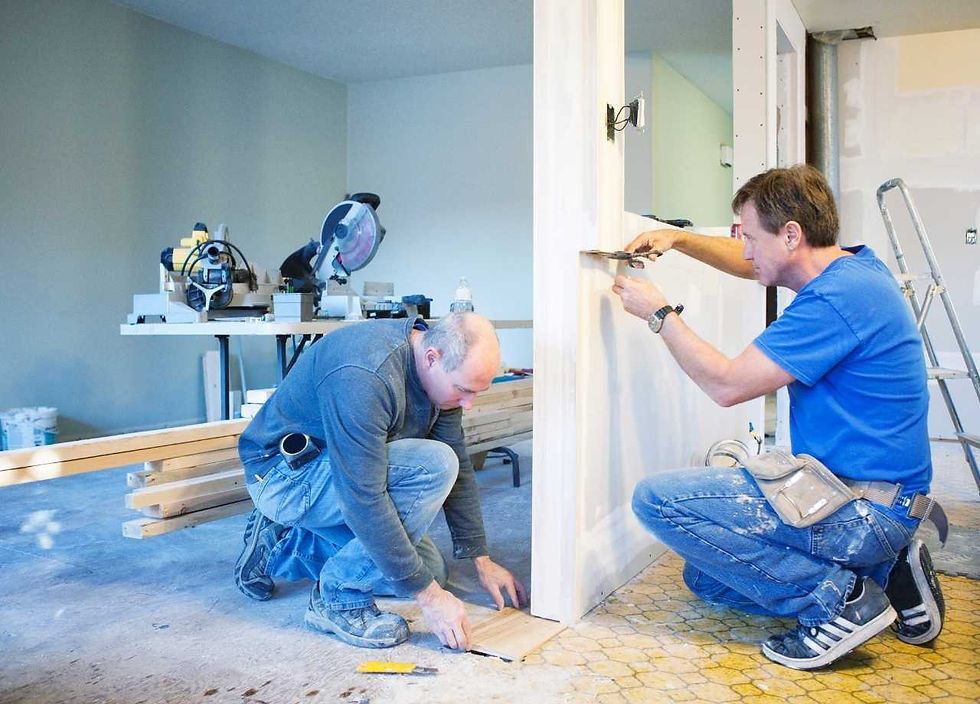The Push for Net Zero: How the OBBB Encourages Eco-Friendly Commercial Renovations
- Muhammad Asif
- Aug 19
- 6 min read
Updated: Sep 1

Ontario’s Building Better Buildings (OBBB) initiative has become a strong driver in pushing commercial property owners toward high-efficiency renovations. What started as a regional code refinement has evolved into a performance-based standard that increasingly rewards low-carbon strategies, penalizes energy waste, and leverages permitting advantages to accelerate progress.
For owners, developers, and commercial landlords operating in suburban areas, ignoring the OBBB benchmarks can quickly become a financial misstep. Incentives are aligning across provincial agencies, utility companies, and municipal permitting offices to favor buildings that push toward net-zero readiness. The smarter route isn't a passive adaptation to code—it’s strategic, data-backed renovation that positions the asset for long-term operational savings and regulatory resilience.
Let’s look closely at how solar energy systems, energy retrofits, and intelligent building controls can be integrated into OBBB-aligned upgrades—and how these moves create more than just compliance wins.
Solar Integration: Beyond Roof Panels
Solar systems are no longer add-ons or symbolic gestures. Under the OBBB’s performance pathway, they can be used to offset key energy-use penalties and improve a building’s Energy Use Intensity (EUI) rating. The catch? It’s not enough to throw PV panels on a roof and call it sustainable. Proper alignment with OBBB compliance means considering system placement, building orientation, inverter configuration, battery storage integration, and even how electricity metering is structured.
South-facing panels on a tilt-optimized angle will still give strong yields, but newer regulations favor buildings that include peak-demand offsetting strategies. That’s where battery storage shifts from optional to valuable. Owners who combine solar arrays with lithium-ion battery systems can shave demand charges, create emergency backup capacity, and maximize time-of-use rate arbitrage—especially in commercial zones subject to variable tariffs.
It’s also worth noting that solar integration under OBBB isn’t just evaluated on production potential. Solar-ready design is rewarded. This means electrical infrastructure, panel supports, and roof penetrations must be pre-configured—even if the full array is scheduled for Phase 2 of the build. Developers who wait to “add solar later” may find themselves failing to hit required TEDI (Thermal Energy Demand Intensity) or TEUI (Total Energy Use Intensity) targets simply because passive readiness wasn’t considered in early-stage planning.
For larger suburban commercial centers, there’s another angle: parking lot solar canopies. These structures not only generate power but also contribute to stormwater management and vehicle shading—elements that can be tied into green infrastructure credits or municipal density bonuses. It's this multifaceted return that makes solar strategy in commercial retrofits far more compelling than the superficial installs of years past.
Energy Retrofits That Move the Needle
OBBB doesn’t merely encourage upgrades—it structurally favors retrofits that make deep energy cuts. Cosmetic energy improvements won’t hit the benchmarks anymore. To see meaningful gains under the program, property owners must target building envelope efficiency, HVAC load reductions, and thermal bridging mitigation.
One high-impact move: re-cladding with continuous exterior insulation. Especially for commercial buildings constructed in the 1980s through early 2000s, existing façades often lack the uninterrupted thermal barrier needed to reach OBBB’s TEUI targets. Upgrading to high-performance cladding systems with integrated insulation and low-conductivity anchors can reduce thermal transmittance by up to 50%, dramatically improving heat retention and lowering mechanical load.
Another focus area is commercial HVAC retrofitting. Traditional rooftop units or legacy chillers aren’t compatible with the thermal targets demanded under current code. Property owners who opt for variable refrigerant flow (VRF) systems, air-source or ground-source heat pumps, and demand-controlled ventilation setups are seeing not just energy reductions, but operating savings that accelerate ROI. In mixed-use suburban developments, where occupancy varies drastically from 8 a.m. to 8 p.m., these systems offer zone-specific control that aligns closely with the energy modelling methods accepted under OBBB protocols.
Windows remain a common retrofit trap. Too many owners invest in double glazing without considering solar heat gain coefficients (SHGC) or thermal breaks. For compliance, the upgrade must be more than glass replacement—it should include framing improvements, low-e coatings tuned to building orientation, and integration with automated shading systems to prevent overheating during peak sun hours.
Retrofitting is no longer about patching inefficiencies. Under the OBBB structure, the goal is to create a tightly sealed, thermally efficient shell paired with systems that respond dynamically to real-world load patterns.
Smart Building Systems and Ongoing Performance Monitoring
Technology is no longer an optional layer in commercial buildings—it’s integral to long-term compliance. Building automation systems (BAS), fault detection tools, and advanced energy metering are all considered best practices under the OBBB performance pathway.
What gives smart systems an edge is their ability to convert performance modeling into real-time responsiveness. A building that passes OBBB code review on paper but performs poorly in operation could be flagged under future maintenance audits. Smart systems help prevent this discrepancy by aligning HVAC, lighting, and plug load use with real-time occupancy and external conditions.
Some of the most valuable installations now include sub-metering at the tenant or system level. This isn’t just a management convenience—it’s a requirement for effective monitoring-based commissioning (MBCx), which will soon become a baseline expectation under expanded OBBB frameworks. Properties with a solid MBCx foundation can adjust energy strategies seasonally, isolate anomalies faster, and demonstrate post-renovation compliance with empirical data—not just theoretical models.

Additionally, these systems make it easier to integrate demand response strategies. As more suburban grid operators implement time-based pricing or dispatchable load programs, smart commercial buildings can pre-cool or shed load on command, unlocking further utility rebates and energy credits. Tenants benefit from more stable comfort conditions, and owners see lower operating costs.
Data storage and cybersecurity in BAS design also deserve attention. With new requirements for system interoperability and privacy compliance, OBBB-aligned buildings must treat digital infrastructure with the same level of design intent as physical upgrades. Failing to secure controls networks or enable remote patching protocols could not only create building downtime but put permit renewals or rebates at risk.
Permitting Advantages and Financial Incentives
One of the most underappreciated components of OBBB compliance is how it speeds up approval timelines and unlocks financial pathways. Municipalities increasingly reward projects that go above minimum code with expedited permitting, density relief, or development charge reductions.
These benefits aren’t just available at the downtown core. Suburban municipalities—especially those aiming to attract more commercial tax base—are adopting performance-based fast tracks. In many regions, commercial retrofits that include solar arrays, VRF systems, and BAS monitoring have received planning approval in weeks, not months, cutting holding costs and allowing faster tenant occupancy.
There are also targeted funds available through Enbridge’s Custom Retrofit Program and Save on Energy’s Existing Building Commissioning initiative. These programs prioritize projects that align with OBBB methodology and can demonstrate measurable emissions reductions. Building owners who combine these with Canada Infrastructure Bank financing or CMHC’s MLI Select for mixed-use properties can stack incentives, offsetting capital costs by up to 40% in some cases.
Tax depreciation also plays a role. Accelerated capital cost allowance (CCA) classes for renewable systems and high-efficiency upgrades allow property owners to recover renovation costs quickly—especially when applied as part of a long-term energy performance contract.
Planning for Future Code Shifts
What makes OBBB worth taking seriously isn’t just the current targets—it’s the direction of the code. TEUI and TEDI benchmarks are already being phased downward every few years. Today’s compliance will not guarantee tomorrow’s occupancy permit.
Smart owners are renovating not just to meet today’s targets, but to future-proof their assets. This means selecting HVAC systems that can be upscaled, designing solar-ready roof infrastructure, and ensuring all controls systems support over-the-air firmware updates and integration with future provincial platforms.
Planning for this future also includes embodied carbon. While OBBB currently centers on operational energy, momentum is growing to integrate lifecycle analysis into commercial permitting. Properties that retrofit with low-carbon materials, modular elements, and local supply chains will be ahead of the curve when embodied emissions targets are rolled out.
Final Word
Commercial property owners operating in Ontario’s suburban markets can’t afford to view OBBB as a box to check. It’s a gateway to smarter energy strategy, more bankable renovations, and long-term resilience against tightening environmental codes.
With solar systems designed for demand offset, envelope and HVAC retrofits that slash TEUI, and intelligent controls that bring operations in line with energy modeling, properties can meet and exceed code—not just now, but for years to come.
The path to net zero isn’t theoretical anymore. The OBBB is making it a permitting reality. Owners who treat this as a strategic opportunity, not a compliance burden, are already outpacing the market.








